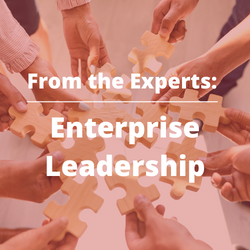
The modern business world is more complex and specialized today than ever before. Enterprise leaders are needed to bring together different departments, teams, and functions to drive the success of the business as a whole. Enterprise leadership is thinking beyond one’s own business unit or function – considering the entire organization and how their function or unit effects it. We asked our team of experts what gets in the way of individual leaders becoming enterprise leaders, and what steps they can take to develop an enterprise mindset.
Answers From the Experts:
 Lyn Turknett, Co-founder and Co-chair, TLG
Lyn Turknett, Co-founder and Co-chair, TLG
Based on what you’ve been seeing, what gets in the way of leaders moving from just individual leadership to enterprise leadership?
I remember distinctly a conversation with a leader who had just hired two new employees and was startled by the difference in their attitudes. One seemed competent but waited to be told what to do, while the other was already thinking strategically about how the business made money and was coming into her office with ideas. He was “thinking like an owner.” She could see that he might be more challenging to manage, but also saw that he could clearly contribute to the business – he already was building an enterprise mindset.
Manika Gandhi argues in Building an Enterprise Mindset that the business environment has become so complex, and decision-making so distributed, that an enterprise mindset is becoming essential not just at the top but within leaders at all levels. Leaders who see themselves not simply as leaders of a team, a function, or a department, but as leaders focused on the success of the entire organization will be positioned to become successful leaders at the enterprise level.
As the nature of work changes, I think we’ll need for every person in the organization to develop an enterprise mindset. These people will, in the words of our Leadership Character Model, “Focus on the Whole” – they will think about the impact of any action not just on their own area, but on the entire organization. One of my favorite sayings is, “No one should use the word ‘they’ for any other part of the same organization.”
Read Lyn’s full article on Enterprise Leadership here.
How can leaders develop an enterprise mindset that focuses on the organization as a whole?
Here are six tips that anyone in the role can use to develop a enterprise leadership mindset:
-
- Cultivate a curious mindset – and as you do the things suggested below – remember Edgar Shein’s term: Humble Inquiry. Read his book by the same name, and read Adam Grant’s Think Again.
- Wherever you are in the organization, learn as much as you can about the business as a whole. What’s the business model? How does the business make money? What’s the current strategy – what differentiates your company from others in the same space?
- Build relationships across the enterprise. Ask questions and listen carefully. Know the goals of other parts of the organizations and think about how your work connects to theirs.
- Ask yourself frequently – what one thing would I do if I were the leader of the organization?
- Read the business press and get involved in outside organizations – know your industry.
- In every decision you make and every goal you set, think how that will affect other parts of the organization.
 Marty Gupta, Vice President of Strategic Services, TLG
Marty Gupta, Vice President of Strategic Services, TLG
Based on what you’ve been seeing, what gets in the way of leaders moving from just individual leadership to enterprise leadership?
Functional Silos – We live in an increasingly specialized world. This is true in business functions as it is in individual occupations. Companies are compartmentalized by function, senior teams consist of functional advocates, and most CEOs have specialized backgrounds. Enterprise leaders must overcome individual, team, and organizational biases.
An Efficiency Mindset – Are businesses over-optimized, too lean, and more at risk? Are decision-makers missing out on larger opportunities due to an efficiency mindset? These are the questions posed in, When More Is Not Better: Overcoming America’s Obsession with Economic Efficiency, by Roger Martin.
The author questions a way of thinking that views business as a machine that can be divided into parts, each part optimized, and then added back together to make an optimal whole. This perfectible-machine model comes at a cost: resilience. Increased efficiency and optimization make systems less adaptable and subject to shocks, as we saw with the COVID Pandemic. The author argues for a new way of thinking where business is viewed in more natural terms, as a complex and adaptive system that balances efficiency with resilience.
In his 2015 book, Team of Teams: New Rules of Engagement for a Complex World, General Stanley McChrystal came to a similar conclusion:
“The models of organizational success that dominated the twentieth century have their roots in the industrial revolution and, simply put, the world has changed. The pursuit of “efficiency”—getting the most with the least investment of energy, time, or money—was once a laudable goal, but being effective in today’s world is less a question of optimizing for a known (and relatively stable) set of variables than responsiveness to a constantly shifting environment. Adaptability, not efficiency, must become our central competency.“
How can leaders develop an enterprise mindset that focuses on the organization as a whole?
Hire and Develop Generalists – From an early age we are encouraged to specialize in sports and the arts, education, and work. In his 2019 bestseller, Range: Why Generalists Triumph in a Specialized World, David Epstein makes a compelling case for generalists and expanding one’s range. The book begins by contrasting two great athletes – Tiger Woods who specialized at a very early age, and Roger Federer who was the opposite, he played numerous sports (anything with a ball) and specialized later.
The book ends with the example of physicist Andre Geim, the only person to win both the Nobel and Ig Nobel prizes. The Ig Nobel is an award for improbable scientific research that makes you think. Geim won for levitating a frog with strong magnets, and later won the Nobel in Physics for his work on the electromagnetic properties of graphene, one of the strongest materials known.
The book cites scores of examples that are more like Federer and Geim than Woods, where the breakthrough, innovation, or solution was discovered by a generalist.
Utilize One-Time, Small Autonomous Cross-Functional Teams – There are many types of cross-functional teams. Our interest here is in small, autonomous cross-functional teams that are assembled for short periods of time to address specific strategic or operational issues. They can be internal-facing or external-facing. These teams are silo-busters.
In Team of Teams, General McChrystal describes the adoption and scaling of small autonomous teams in Iraq: ‘We dissolved the barriers—the walls of our silos and the floors of our hierarchies—that had once made us efficient. We looked at the behaviors of our smallest units and found ways to extend them to an organization of thousands, spread across three continents. We became what we called “a team of teams”: a large command that captured at scale the traits of agility normally limited to small teams.’
Read – Here are recent books by three of our top business thinkers: A New Way to Think: Your Guide to Superior Management Effectiveness by Roger Martin. Change: How Organizations Achieve Hard-to-Imagine Results in Uncertain and Volatile Times by John Kotter. The Crux: How Leaders Become Strategists by Richard Rumelt.
 Tim Huff, Vice President of Leadership, TLG
Tim Huff, Vice President of Leadership, TLG
Based on what you’ve been seeing, what gets in the way of leaders moving from just individual leadership to enterprise leadership?
Often, for many junior leaders and newly promoted executives, there’s an insecurity influencing their thinking that keeps them operating at the individual leadership mode vs enterprise mode. While they are driven to succeed and prove their worth within their individual accountabilities, they typically see their viewpoints through the lens of “if this doesn’t affect me, there’s not much I can contribute.” Their lack of confidence in the value of their thoughts and opinions and their strong focus on not failing at their job keeps them from thinking at the enterprise level. When participating in discussions and planning on topics outside their immediate responsibility, they often see their input and participation as optional. Although it’s vitally important for leaders to deliver success according to the performance expectations outlined for them, true leadership at the enterprise level requires more than that.
How can leaders develop an enterprise mindset that focuses on the organization as a whole?
A key aspect of enterprise leadership is an understanding of, and full participation in, the organization’s vision and strategy. Full participation doesn’t mean simply seeing their team as a cog in the organization’s wheel, responsible for only their individual piece. It means buying in to the organization’s vision, taking ownership in the success of the enterprise, and taking action to ensure the enterprise strategy moves forward. One way that leaders can start to shift into enterprise-level thinking is to spend more time with their peers who have parallel accountabilities, learning about their goals, strengths, and challenges. With this insight, leaders can synergize their teams, helping with their challenges and accepting help from their strengths. Doing things like this consistently and with more peers will naturally build a culture where the overall organization’s success is prioritized higher than individual team success.
Explore the rest of our team!

